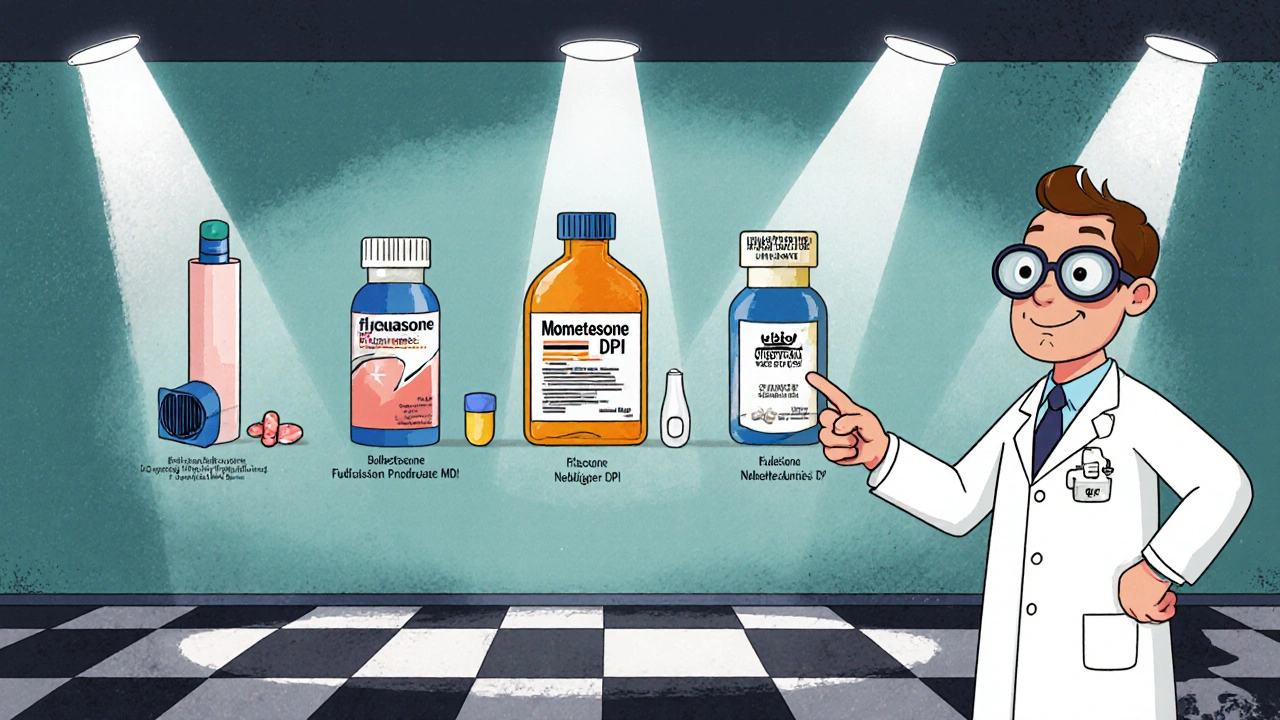Beclomethasone Dipropionate vs Other Steroid Inhalers: A Practical Comparison
 Oct, 15 2025
Oct, 15 2025
Inhaled Steroid Potency Calculator
Compare Your Inhaled Steroid
Select a steroid to see how it compares to beclomethasone dipropionate in terms of potency, device type, and key characteristics.
When you hear the name beclomethasone dipropionate, you probably picture a small inhaler that helps keep asthma symptoms at bay. It’s a long‑standing inhaled corticosteroid (ICS) that’s been prescribed for decades. But the market now offers a handful of other options, each with its own quirks. This guide walks you through the science, the practical differences, and the key factors to consider when you’re choosing an ICS or an alternative therapy.
Key Takeaways
- Beclomethasone dipropionate (BDP) is a medium‑potency inhaled corticosteroid, often delivered via metered‑dose inhaler (MDI).
- Fluticasone propionate and budesonide are the most common high‑potency rivals, while mometasone furoate and ciclesonide sit in the same potency range.
- Combination products (ICS+LABA) like fluticasone/salmeterol simplify dosing for many patients but add cost.
- Non‑steroid options such as montelukast work differently and may suit patients who can’t tolerate steroids.
- Device type (MDI vs dry‑powder inhaler) can influence adherence as much as the drug itself.
What Is Beclomethasone Dipropionate?
Beclomethasone dipropionate is a synthetic glucocorticoid designed for inhalation. It belongs to the class of inhaled corticosteroids that reduce airway inflammation by binding to glucocorticoid receptors in the bronchial epithelium. First approved by the FDA in 1978, BDP is typically supplied as a metered‑dose inhaler (MDI) with particle sizes engineered for deep lung deposition. Its pro‑drug form converts to the active beclomethasone‑17‑monopropionate in the airways, offering a rapid anti‑inflammatory effect while limiting systemic exposure.
How Does It Work?
When you inhale BDP, the tiny droplets travel into your bronchi. Inside the lungs, esterases cleave the propionate groups, releasing the active steroid. This molecule then binds to intracellular glucocorticoid receptors, altering gene transcription to suppress cytokines, eosinophils, and other mediators that cause swelling and mucus production. The net result is smoother airways and fewer asthma attacks.

Other Inhaled Corticosteroids on the Market
Below are the most common alternatives you’ll encounter, each with its own profile.
Fluticasone propionate is a high‑potency corticosteroid often delivered via dry‑powder inhaler (DPI) or MDI. It boasts strong receptor affinity and a longer pulmonary residence time.
Budesonide is a medium‑potency steroid available in both DPI and nebulizer forms. Its rapid onset makes it popular for both maintenance and rescue regimens.
Mometasone furoate is a newer, very high‑potency inhaled steroid, usually found in DPI format. It’s often praised for its once‑daily dosing.
Ciclesonide is a pro‑drug like BDP, activated in the lungs to des‑isobutyryl‑ciclesonide. It’s known for low oral bioavailability, reducing systemic side effects.
Montelukast is not a steroid at all; it’s a leukotriene receptor antagonist taken orally. It works by blocking leukotrienes, another pathway that narrows airways.
Side‑by‑Side Comparison
| Drug | Potency (relative to BDP) | Typical Device | Onset of Action | FDA Approval Year |
|---|---|---|---|---|
| Beclomethasone dipropionate | 1× (baseline) | MDI | 30‑60min | 1978 |
| Fluticasone propionate | 1.5× | DPI / MDI | 45‑90min | 1994 |
| Budesonide | 0.8× | DPI / Nebulizer | 15‑30min | 1981 |
| Mometasone furoate | 2× | DPI | 45‑90min | 2005 |
| Ciclesonide | 1× | MDI | 30‑60min | 2005 |
Choosing the Right Inhaler for You
Deciding between BDP and its rivals isn’t just about chemical potency. Think about these real‑world factors:
- Device preference: If you struggle with coordination, a DPI that’s breath‑activated (fluticasone, mometasone) might be easier than an MDI that needs a spacer.
- Dosing frequency: Some patients love once‑daily regimens (mometasone, ciclesonide), while others don’t mind twice‑daily dosing with BDP.
- Cost and insurance: Generic BDP inhalers are often cheaper than brand‑only DPIs. Check your formulary.
- Side‑effect tolerance: If you’ve experienced oral thrush with high‑potency steroids, stepping down to a medium‑potency option like BDP or budesonide may help.
- Age and inhalation technique: Children under 5 often benefit from a spacer with an MDI; older teens and adults might handle a DPI just fine.
For many, the best choice ends up being a combination of drug and device that fits their daily routine. Talk to your pharmacist or prescriber about a trial period-most insurers allow a short‑term switch to see how you respond.

Safety, Side Effects, and Monitoring
All inhaled corticosteroids share a safety profile that includes local effects (hoarseness, oral candidiasis) and, at high doses, potential systemic absorption leading to adrenal suppression or bone density loss. Here’s how BDP stacks up:
- Local irritation: Rinse your mouth after each use; a quick water swish can cut thrush risk by up to 70%.
- Systemic exposure: Because BDP is a pro‑drug, its systemic bioavailability is lower than fluticasone but higher than ciclesonide.
- Growth impact in children: Studies show a modest, dose‑dependent reduction in height velocity; regular pediatric checks are advised.
- Drug interactions: Strong CYP3A4 inhibitors (ketoconazole, ritonavir) can raise steroid levels; inform your prescriber.
Regular follow‑up appointments should include lung function tests (spirometry) and a review of inhaler technique. If you notice persistent hoarseness or cough, your clinician might lower the dose or add a spacer.
Practical Tips for Getting the Most Out of Your Inhaler
- Shake the MDI for at least 5 seconds before each use.
- Exhale fully, then press the inhaler and inhale slowly and deeply.
- Hold your breath for about 10 seconds after inhalation to allow the particles to settle.
- Rinse your mouth with water (spit out) after every dose.
- Store the inhaler at room temperature; avoid extreme heat or cold.
These habits not only boost drug delivery but also cut down on side effects. If you’re using a spacer, remember to clean it weekly to prevent bacterial buildup.
Frequently Asked Questions
Can I switch from beclomethasone dipropionate to another inhaled steroid without a doctor’s order?
Technically you could, but insurance coverage, dosing equivalence, and inhaler technique often require professional guidance. Talk to your prescriber before making a change.
Is beclomethasone dipropionate safe for pregnant women?
Inhaled steroids are generally considered low‑risk during pregnancy because systemic absorption is minimal. Nonetheless, discuss the benefits and any concerns with your obstetrician.
How does the potency of beclomethasone compare to fluticasone?
Fluticasone propionate is roughly 1.5 times more potent on a microgram‑for‑microgram basis. That means you need a lower dose of fluticasone to achieve the same anti‑inflammatory effect as BDP.
Do I need a spacer with beclomethasone dipropionate?
A spacer isn’t mandatory, but it can improve drug deposition, especially for children or anyone who struggles with coordination. Using one can reduce oral thrush risk by up to 30%.
What are the main non‑steroid alternatives for asthma control?
Leukotriene receptor antagonists like montelukast, long‑acting beta‑agonists (LABAs) used in combination inhalers, and biologics (e.g., omalizumab) for severe cases are common non‑steroid options.
Ultimately, the “best” inhaled medication is the one you’ll actually use every day. Compare potency, device ease, cost, and side‑effect profile, then have a candid conversation with your healthcare team. With the right match, you’ll breathe easier and keep asthma attacks in check.

Rebecca Mikell
October 15, 2025 AT 20:31I've been using beclomethasone dipropionate for a few years now and I really appreciate its consistency. The MDI format works well for me because I can pair it with a spacer when needed. Rinsing my mouth after each use has kept thrush at bay, which is a simple habit that makes a big difference. It's also nice to see that generic versions are usually cheaper than the newer DPIs. Overall, it’s a solid, reliable option for everyday control.
Alyssa Griffiths
October 16, 2025 AT 18:45Honestly, the pharma giants are pushing these inhalers like they're the only answer, and it's quite suspicious, really. They love to hype up the "latest" devices, using fancy tech jargon, while the old-school BDP just sits there, doing its job, no fireworks. Have you ever noticed how the marketing budget for a new DPI dwarfs the actual clinical advantages? It feels like a coordinated effort to keep us buying brand‑name products, not because they're better. Just saying, keep your eyes open.
dany prayogo
October 17, 2025 AT 16:58Oh sure, let's all bow down to the almighty beclomethasone dipropionate, the so‑called "gold standard" of inhaled steroids, because apparently nothing else matters. It's not like you have a choice when your insurance decides what you can or cannot afford; the system wants you to believe that a medium‑potency MDI is somehow the pinnacle of respiratory care. Meanwhile, the high‑potency fluticasone scoffs at BDP's modest reputation, offering a longer pulmonary residence time that some claim is "more effective"-but who really knows? And let's not forget budesonide, that speedy little firecracker that promises rapid onset, as if speed alone guarantees safety.
Now, the real kicker is the way device preference is almost weaponized: if you can't coordinate an MDI, the market nudges you toward a DPI, as if you suddenly become less competent. The truth is, every device has its quirks, and insisting that breath‑activated inhalers are universally superior is just another marketing ploy. Then there's the whole non‑steroid angle with montelukast, a drug that tries to be the alternative hero, but often ends up being a second line of defense for those who can't tolerate steroids-because the universe apparently loves giving us second choices.
Cost? Oh, the delightful dance of generic BDP inhalers being cheap until your pharmacy decides to hike the price because, surprise, a new brand‑only DPI entered the market. Insurance formularies are a labyrinth designed to keep you guessing, and that, my friends, is the real asthma‑inducing factor. Systemic side effects? Sure, BDP has lower bioavailability than fluticasone, but it's still higher than ciclesonide-so you’re still walking that fine line.
And let’s talk about the infamous oral thrush-rinse your mouth, they say, and you’ll be fine. But have you ever tried doing that consistently, especially when you’re in a rush or just plain annoyed? The whole recommendation feels like a punchline to an inside joke that only pulmonologists find funny.
In the end, the best inhaler is the one you actually use, they say, as if that just magically solves all compliance issues. Nope, it’s about technique, education, and the willingness of the healthcare system to actually listen, not just prescribe. So, while BDP sits comfortably in the middle of the potency spectrum, don’t let it lull you into complacency; keep questioning, keep testing, and maybe, just maybe, you’ll find the right fit for your lungs.
Wilda Prima Putri
October 18, 2025 AT 15:11Sure, because inhalers are the biggest hassle ever.
Sharif Ahmed
October 19, 2025 AT 13:25When one steps into the realm of inhaled corticosteroids, the theatrics begin. Beclomethasone, with its modest 1978 debut, carries the aura of a classic, yet somehow feels unassuming compared to the flamboyant newcomers. The drama of a pro‑drug that converts within the lungs adds a touch of intrigue, but don’t be fooled-it’s still a medication, not a work of art. Its systemic exposure sits somewhere between the heavy‑handed fluticasone and the virtually invisible ciclesonide, a delicate balance of potency and safety. In short, it’s a respectable performer on the stage of asthma management.
Arjun Santhosh
October 20, 2025 AT 11:38i totally get re using BDP i got mine a while back and it works solid. i keep forgetting to swish after shots but i think it helps. also the generic price is nice for my wallet.
Stephanie Jones
October 21, 2025 AT 09:51One could argue that the very act of “rinsing your mouth” is a metaphor for how we cleanse ourselves of complacency. Yet, in the grand tapestry of inhaled therapy, we are often offered simple rituals that mask deeper systemic oversights. It’s almost poetic how the act of spitting becomes a silent protest against the invisible forces that dictate our prescriptions. In the end, perhaps the true inhalation is that of a critical mind.
Chelsea Kerr
October 22, 2025 AT 08:05Hey folks! 😊 If you’re weighing BDP against the newer DPIs, remember that device technique is half the battle. ✅ A spacer can dramatically improve deposition, especially for kids. 🌬️ Also, don’t forget to check your inhaler’s expiration date-using an old canister reduces efficacy. 💡 Finally, if cost is a concern, see if your pharmacy offers a generic MDI, which usually saves a lot. 🎉 Stay well and keep breathing easy!
Tom Becker
October 23, 2025 AT 06:18Yo, that fluticasone thing is just hype. i think BDP is more real. sometimes i feel the new inhalers are just a way 2 make more $.
Laura Sanders
October 24, 2025 AT 04:31Let's be clear: beclomethasone's potency is a baseline, not a ceiling. The pharmacokinetics are well‑documented, and any claim of inferiority is purely anecdotal. When you compare dosage equivalence, the numbers line up without any magical adjustments. Hence, for most patients, BDP remains a pragmatic choice.
Jai Patel
October 25, 2025 AT 02:45Yo! 🌟 Love the practical tips from Chelsea. 🎈 Just adding that if you’re into cultural vibes, many Indian pharmacies stock BDP at a fraction of the cost-just ask your local pharmacist. Also, using a simple spacer can feel like a mini‑dance, but it hugely boosts drug delivery. Keep the flow smooth and the lungs happier! 🎶
Zara @WSLab
October 26, 2025 AT 00:58Really appreciate the supportive vibe here 😊. If anyone is still unsure, trying a short trial period with their doctor can clarify which device feels best. Remember, consistency beats perfection any day. Keep sharing your experiences, it helps everyone!
Randy Pierson
October 26, 2025 AT 22:11Grammar note: "inhaler" is singular, "inhalers" is plural. Also, "its" versus "it's"-watch the apostrophe. Keep those sentences crisp!
Bruce T
October 27, 2025 AT 20:25Listen up, people. It's not just about which steroid you pick; it's about personal responsibility. If you skip your dose because it's inconvenient, no drug, no matter how fancy, will save you. So get your act together, set reminders, and stop making excuses. That's how you truly manage asthma.
Darla Sudheer
October 28, 2025 AT 18:38Good point about reminders. They're simple but effective.
Elizabeth González
October 29, 2025 AT 16:51In contemplating the comparative efficacy of inhaled corticosteroids, one must adopt a methodical stance. The pharmacodynamic profiles of BDP and its counterparts exhibit nuanced divergences that merit rigorous appraisal. Moreover, patient adherence intertwines inexorably with device ergonomics, a factor often underappreciated in clinical discourse. Thus, an integrative approach, balancing potency, convenience, and cost, is requisite for optimal therapeutic outcomes.
Sebastian Samuel
October 30, 2025 AT 15:05Exactly, Elizabeth-let's not forget the psychological comfort of familiar devices! 😜 Consistency breeds confidence, and confidence keeps the airways clear. Keep the conversation going, folks.